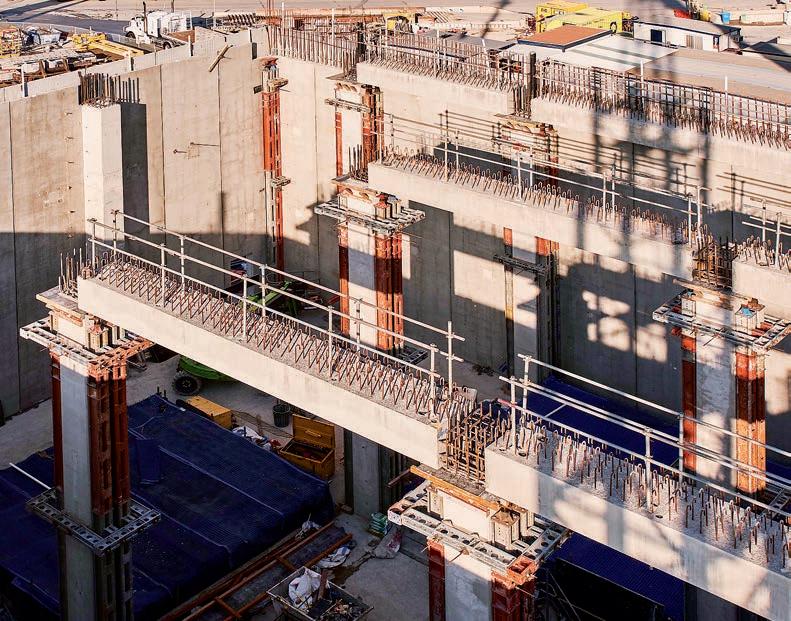
4 minute read
Double wall system
The WestConnex construction team turned to precast concrete to construct an integral part of the infrastructure build.
PRECAST ON THE DOUBLE
A PRECAST DOUBLE WALL SYSTEM MANUFACTURED OFFSITE SAVED CONTRACTORS TIME AND RESOURCES ON THE M5 MOTORWAY TUNNEL IN NEW SOUTH WALES. P recast concrete has traditionally been used in projects that have strict time and space restrictions.
Creating large wall structures onsite often uses a large amount of space and can require complex scaffolding arrangements and concrete pumping equipment.
The WestConnex was one such project with site and time restrictions. As a solution, the construction team turned to precast concrete to efficiently construct an integral part of the infrastructure build.
The WestConnex is one of Australia’s largest road projects, involving the construction of 33 kilometres of motorway to link west and southwest Sydney.
As part of the WestConnex, Sydney’s M5 motorway will be duplicated from Beverly Hills to St Peters, including the construction of twin underground motorway tunnels.
Located in Arncliffe, near Sydney Airport, the nine-kilometre-long twin tunnels began construction in July 2016 and are set to open to commuters this year.
CPB Contractors, Dragados and Samsung in a joint venture were awarded the build contract for the project by the WestConnex Delivery Authority.
One of the first challenges with any tunnel build is ensuring the tunnel has efficient and modern ventilation systems from earthmoving right through to the final product. On such projects it is crucial for contractors to meet strict global air quality standards to protect workers and commuters inside and outside of the tunnel.
To ensure the project met these standards, it was decided an exhaust vent and supply vent building were to be used to operate continually and in conjunction with each other for the M5 Motorway tunnel.
The exhaust vent building treats and removes used air (vehicle exhaust) from the tunnel, while the supply vent building introduces new clean air into the tunnel.
Due to the limited space around the exhaust vent building, it was decided that undertaking formwork would be too difficult and pouring 12-metre-tall walls at full height in-situ was also an excessive challenge.
Precast concrete walls were used to create the exhaust vent building. As precast concrete is manufactured offsite, this proved an ideal solution for the space limitations on the M5 Motorway project.
In 2018, National Precast member Austral Precast was contracted to manufacture its double wall system for the exhaust vent building. The precast elements would make up the monolithic structure of the building.
Austral Precast State Sales Manager Sanket Das says the exhaust vent building was very tall, and there were restrictions with the amount of available space on the project to allow efficient construction activity.
“The project was also under strict
construction timeframes, and conventional formwork methodology would not have solved any of these challenges,” Mr. Das says.
Austral Precast had a six-month window for the project to manufacture the precast walls before they were transported to the site using a semi-trailer.
For onsite installation, a mobile crane was required to lift the panels into place using the designated lift points.
“The precast double wall system provided all the benefits of offsite factory production, with the client gaining a greater amount of space on the construction site,” Mr. Das says.
The large and lightweight panels, not often used for infrastructure, proved to be the perfect solution for this project. The panels are created to provide an offform, ready-to-paint finish, meaning once the panels were installed, the ventilation building was ready to go.
The panel system consisted of two precast concrete reinforced concrete shells that were connected by a reinforcement-bar lattice girder. This established a cavity between the two shells, which has been used as a solution for load-bearing walls, and formed a solid concrete structure once the cavity was filled with premix concrete.
“Supporting the structure initially was a challenge, as each of the walls were about 13 metres tall and we needed the right support for the building during construction,” Mr. Das says.
“We coordinated with industry experts and a temporary works engineer designed
National Precast Member Austral Precast was contracted to manufacture a double wall system for the exhaust vent building. Precast panels are created to provide an off-form, ready-to-paint finish.
the many bracing systems that we used to keep the panels in place before the void was filled.”
The double wall system weighs less than solid precast panels and saves on installation costs and time, as they are simply transported to site and craned into place. It also eliminates the need for scaffolding as the structure is being built. On the M5 Motorway project, it enabled construction to


take place within the project’s boundary.
“There is about a 30 per cent weight difference between the double wall system and traditional precast panels because of the void inside the wall, which makes the structure easy to construct,” Mr. Das says.
The system also increases safety by reducing onsite personnel during production and installation.
“The amount of access equipment and infrastructure you need onsite to be able to construct such a wall is heavily reduced because of the double wall system. It’s a complete offsite production before installation,” Mr. Das says.
He says building a 13.5-metre wall conventionally would take an extended amount of time and significant manual effort.
“Because we are manufacturing the panels in a factory, we are doing it in controlled conditions and not subject to the varying conditions on a project site.
“The double wall precast system is a very solid structure from an engineering point of view, because there is a void filled with concrete and there is continuity between all of the precast panels. It was a great option for a project like the M5 Motorway tunnel,” Mr. Das says.










